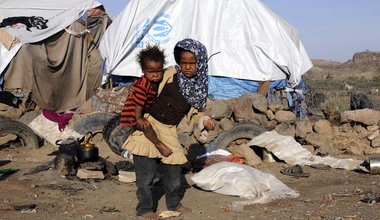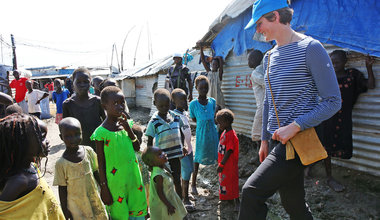Some 3,500 people fleeing South Sudan each day due to ongoing conflict – UN refugee agency
 The ongoing conflict in South Sudan has led to immense suffering and displacement, with an average of 3,500 people fleeing the country each day to neighbouring countries, prompting the Office of the United Nations High Commissioner for Refugees (UNHCR), national authorities, and other humanitarian actors to race to create safe and humane conditions for arrivals – 90 per cent of whom are women and children.
The ongoing conflict in South Sudan has led to immense suffering and displacement, with an average of 3,500 people fleeing the country each day to neighbouring countries, prompting the Office of the United Nations High Commissioner for Refugees (UNHCR), national authorities, and other humanitarian actors to race to create safe and humane conditions for arrivals – 90 per cent of whom are women and children.
People are fleeing South Sudan to the Democratic Republic of the Congo (DRC), Ethiopia, Sudan, and Uganda, which has seen the greatest number of outflow, with 2,400 arrivals every day since early October and a quarter million new refugees since the re-eruption of violence in Juba that began on 7 July 2016.
UNHCR reports that most refugees are fleeing the Equatoria regions of South Sudan, which borders Uganda and is home to Juba. People leaving the region are reporting harassment by armed groups, killings and torture of people suspected of supporting opposing factions, villages set on fire, sexual assault of women and girls, and forced recruitment of young men and boys.
As armed groups have prevented people from using main roads, refugees in recent weeks are increasingly using informal border crossing points. Many have walked through the bush for days without food or water.
The Bidibidi refugee settlement in Uganda, opened only in August of this year, is now one of the largest refugee-hosting areas in the world and home to 170,000 South Sudanese refugees.
“Providing immediate, life-saving assistance, including food, water and shelter remains UNHCR’s key priority,” said Cécile Pouilly, UNHCR spokesperson at the regular press briefing in Geneva. “But severe underfunding is hampering our efforts on the ground.”
She also cited challenges with water supply efforts in Bidibidi, as needs are quickly outpacing resources. UNHCR is working to identify water sources for the camp, as water is currently being provided via trucks from a treatment plant 50 kilometres away – an extremely costly option.
In Ethiopia, Nguenyyiel, a new refugee camp that was opened on 20 October after existing camps became full, has the capacity to host 50,000 people. Shelter, water, and basic sanitation services are in place and 6,200 refugees have already been relocated to the new camp. 36,000 arrivals have been registered since the start of September and some 630 people continue to arrive each day.
Those arriving in Ethiopia are typically from the Upper Nile region of South Sudan, where conflict and fear of renewed fighting have led them to flee their homes. Others from the Jonglei state, which is north of the capital, Juba, cited food shortages as their reason for leaving.
Some 85 per cent of refugees leaving South Sudan are women and 65 per cent are children under the age of 18. More than 1,300 unaccompanied children and 6,200 separated children have been registered in various camps throughout neighbouring countries. Interviewers have found that most unaccompanied children are alone because their parents are dead or because they were either abandoned or separated from their families during the flight.
In Sudan, there are now more than 250,000 refugees from South Sudan, most of whom arrive in the White Nile state at a rate of 2,000 per month. Sporadic flows into South and West Kordofan states and East Darfur have also been recorded. More than 47,000 refugees since mid-June are in East Darfur, but the majority are spread across the country, not living in organized camps or settlements.
Those arriving in Sudan, especially women, children, and the elderly, arrive in poor conditions. They have fled areas that are facing emergency levels of acute malnutrition and they have been weakened by difficult journeys during the rainy season.
In the DRC, some 60,000 people have arrived since July 2016 and have settled along the border with South Sudan, where armed groups remain active in some areas. Teams on the ground report that most refugees are arriving without any belongings from Yei, a city in the Central Equatoria state.
The Ituri Province of the DRC is currently facing the largest influx of refugees. Earlier this week, the UNHCR began to transfer an estimated 40,000 people from remote border areas. For now, refugees will be sent to Biringi, a site near the city of Aru in the northeastern province of Ituri. Two other sites have been identified, although the operation is facing major logistical challenges given the poor condition of roads.
An additional 4,000 refugees who moved on their own from the border to Meri in Haut-Uele Province have been provided with drinking water and basic services, and the World Food Programme began making distributions this week.
The goal for refugees in all sites is to supply them with plots of land, construction materials, household goods, and agricultural tools to help them become self-sufficient.
 UN
UN








